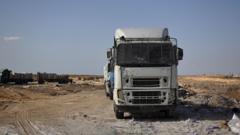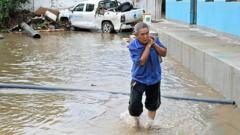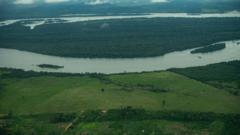This article examines the recent catastrophic floods in Valencia, where over 200 lives were lost, focusing on the geography, climate, and emergency measures that exacerbated the disaster.
Tragic Aftermath of Valencia Floods: A Deep Dive into the Disaster's Causes

Tragic Aftermath of Valencia Floods: A Deep Dive into the Disaster's Causes
Analyzing the critical factors that contributed to the devastating floods in Valencia, revealing the implications of climate change and urban planning failures.
The recent flash floods that struck the Valencia region of Spain have left the country grappling with a staggering death toll, currently exceeding 200 fatalities. The town of Paiporta, with a population of 25,000, has been particularly hard-hit, reporting at least 62 deaths amid the chaos. The tragedy has raised critical questions about the reasons behind such a high number of casualties, with various factors at play.
One alarming trend has been the number of drivers trapped in their vehicles as flood waters rose rapidly. Many individuals were en route home after work when the floods struck unexpectedly. Emergency alerts were issued by the civil protection agency after 8 PM local time, but for many, it was too late. Video footage captures the horror of floodwaters surging through Paiporta while vehicles remained on the streets, further complicating rescue efforts.
Local authorities have been criticized for an apparent lack of preparation. Mayor Maribel Albalat pointed out the town's vulnerability due to poor urban planning, which includes numerous ground-floor flats susceptible to flooding. Tragically, this left some residents trapped, including six individuals from an elderly care home that inundated rapidly.
Eyewitness accounts shared harrowing detail, with survivors recounting their desperate struggles against the floodwaters. One survivor was reportedly tied to a lamppost to avoid being swept away, although his fate remains unknown. The mayor of a neighboring town, Chiva, warned that many vehicles lay flipped and submerged, likely still containing occupants.
Garages emerged as particularly perilous locations during the floods. Many residents attempted to salvage their vehicles, only to find themselves in life-threatening situations. At one residential building in the La Torre neighborhood, seven bodies were recovered from garages, highlighting a common misjudgment during such natural disasters.
The geographical layout of Valencia, dominated by impermeable surfaces due to extensive urban development, played a crucial role in the flooding's severity. Research indicates that climate change intensified rainfall, with scientists estimating that the precipitation was about 12% heavier than it would have been otherwise. Such circumstances underscore the need for more effective disaster preparedness and resilience strategies to mitigate future flooding events.
As the aftermath of this calamity unfolds, local authorities face increasing scrutiny regarding their emergency response strategies and urban planning practices. Meanwhile, warnings have been extended to other regions of Spain as forecasters predict additional rain, underscoring the urgent need for communities to be adequately prepared for extreme weather, driven in part by the ongoing climate crisis.





















